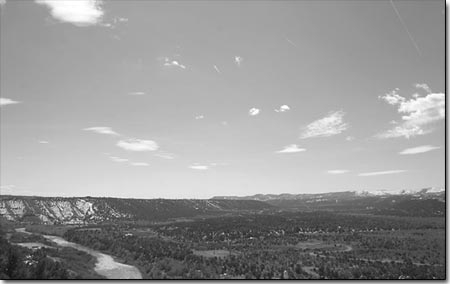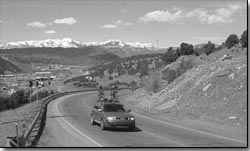|
Four Corners ozone levels predicted to stay below
federal standard
by Missy Votel
 |
Views such as this should not
become obscured with pollution over the next several years,
according to a computer analysis conducted by the New Mexico
Air Quality Bureau, which predicts that ozone, or smog, levels
in the Four Corners will stay within acceptable
federal standards./Photo by Todd Newcomer. |
There is a silver lining to the ozone cloud hovering over the
Four Corners, says a State of New Mexico air quality expert. There
had been concerns that levels of the toxic gas generated from
emissions would exceed federal levels.
However, according to Mary Uhl, of the New Mexico Environmental
Department’s Air Quality Bureau, recent computer models
show that while the area’s ozone levels are unusually high,
they are not expected to exceed federal standards over the next
several years.
“What we are predicting is that we are not going to see
that area exceed federal standards,” she said. “This
is good news.”
Uhl said the predictions are especially welcome given the projected
growth in the area as well as the addition of up to 13,000 new
gas wells and three coal-fired power plants in northern New Mexico.
“Even with growth and the new power plants, we still saw
compliance with federal standards,” she said.
Uhl said ozone is expected to remain at acceptable levels because,
although the area is growing, new federal mandates are helping
to lower ozone-causing emissions.
“It’s kind of balancing itself out,” she said.
“What we are saying is not that the situation will get better,
but it will basically stay the same.”
The computer modeling was based on data collected by the Four
Corners Ozone Task Force, an advisory group made of varied interests.
The task force was formed in October of 2002 in response to ozone
readings near Farmington that rival those found in larger cities,
such as Los Angeles, and have come close to exceeding federal
standards. If the area is found to exceed federal standards of
84 parts per million (the three-year average for the area from
2000-2003 is about 76), the Environmental Protection Agency would
step in to clean things up, a step which could have a significant
economic impact on the area. As a result, the task force was formed
to help come up with local solutions to the ozone problem.
Ground-level ozone (as opposed to that found in the stratosphere),
commonly known as smog, is a toxic brew that forms when nitrogen
oxides and volatile organic compounds react with sunlight and
heat. The resulting substance, when inhaled, triggers respiratory
ailments, particularly among children and people who are active
outdoors. Such ailments include reduced lung capacity, bronchitis
and aggravation of asthma. Repeated exposure over several months
can cause permanent lung damage.
Typical sources of these pollutants are power plants, combustion
engines and oil and gas compressors. In the Four Corners, the
biggest emitters of ozone-making particles are the San Juan Generating
Station and the Four Corners Power Plant, both near Farmington.
Although the plants are more than 60 miles from Durango, ozone
can be transported many miles from its source by wind, making
it a basinwide problem.
Dan Randolph, of the San Juan Citizens’ Alliance, an ardent
watchdog of the oil and gas and power industries, said he does
not necessarily see the predictions as good news.
“We are still very close to the federal limit, and with
this modeling data, what we’re nervous about is everyone
saying ‘There’s no problem,’” he said.
“Meanwhile, ozone is at a level that affects people with
respiratory problems and active adults.”
He also warned of the possibility that the model may prove to
be inaccurate.
 |
| A car crests Farmington Hill
on Monday afternoon. Although ground-level ozone levels in
the area are on par with cities much larger than Farmington
or Durango, they are still within acceptable federal levels
and are predicted to stay there./Photo by Todd Newcomer. |
“If the model is wrong, we’ll find ourselves in a
situation where the EPA steps in and dictates what we have to
do,” he said.
And despite the promising projections, Randolph noted that they
don’t erase that fact that for a rural area, the Four Corners’
ozone levels are unusually high, and steps must be taken to remedy
that.
“We are still going to be living with impaired air quality,”
he said. “We need to still make active efforts to reduce
ozone precursors.”
Uhl agreed that despite the recent news, there is still a problem
at hand.
“The area is still within federal standards, but on the
other hand, it is a rural area. It is surprising to find ozone
levels so high,” she said.
Such ozone levels, she said, are common to cities with half a
million people or more. Even Albuquerque has lower ozone levels
than Farmington.
Although she said she has faith in the model, which has been
used with success in several large cities throughout the country,
it is just one tool in predicting what the future holds. And the
results don’t necessarily mean the task force’s work
is done, either.
“We still need to be vigilant, and maybe the air quality
is not as good as it should be,” she said. “We will
still be meeting with the task force. Our work is not yet done.”
|

